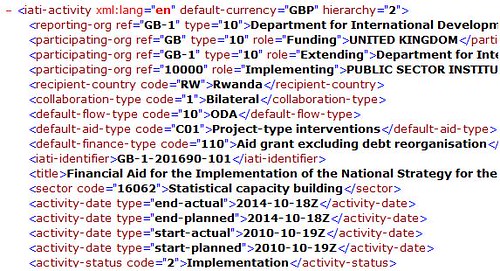The following guest post is by Claudia Elliot from Publish What You Fund.

IATI XML data
After two years of negotiating, the 18 donors of the International Aid Transparency Initiative (IATI) agreed on February 9th the final details of a new global standard for publishing aid information. This format makes aid information internationally comparable, and so more information will now be better information.
DFID has already published its aid information, down to transaction-level data, in the IATI XML format. You can see their beautifully structured data on the IATI Registry. During the course of the year, more of the world’s biggest aid donors will begin to publish information on current aid projects in this standard format. With this format it will now be possible to build a bigger picture of aid activities which means that donors and recipients can coordinate their plans and complement the activities of others, reducing duplication and waste.
Publish What You Fund is currently working with the Open Knowledge Foundation to produce a visualisation of Uganda’s domestic budget with aid mapped onto it. This will show the real power of providing more information about aid flows in a standard format.
##Use this data!
Of course, this information will only be useful if it is used. Please play with this data, and let us know what you make with it. When several donors are publishing to IATI, and then aid flows can be compared and combined, so the best part is yet to come. But even just looking at DFID’s data, it is possible for the first time to find the answers to all sorts of interesting questions:
- Which companies or organisations are the biggest implementers of aid projects?
- Are some better than others in starting on time (the difference between planned and actual start dates)?
- Which sectors (health, education, etc.) does UK aid support, and how does that vary between countries?
- What was the difference between commitments and disbursements in 2010?
- How much money goes to climate change mitigation and adaption?
##More data is now better
The new aid transparency standard provides a common language and format and a single way that donor countries can share information on the aid they are spending. However, to see the bigger picture, we need more data.
By the end of this month, we should know when each of the IATI signatories are planning to release their information in the IATI XML format. Major progress is also being made in the US. Although the US is not an IATI signatory, efforts to coordinate with the newly agreed standard suggest that as the US aid dashboard moves forward, foreign assistance could be mapped to both other donors’ and recipient countries’ own spending.
We’re also working with international partners to develop an Aid Transparency Tracker: a common framework and platform to track whether key types of aid information are available. As part of this, we want to create a public, online tool which tracks levels of available aid information, show changes over time, and facilitates clear, practical improvements in the levels of information.
If you think you could help us with this, please get in touch by emailing Mark at mark.brough[at]publishwhatyoufund.org
This post is by a guest poster. If you would like to write something for the Open Knowledge Foundation blog, please see the submissions page.








